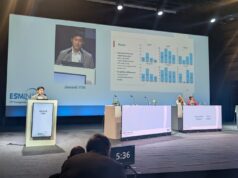
One-year follow-up data from two randomised controlled trials (RCTs) evaluating mechanical thrombectomy in patients with ischaemic strokes caused by large-core infarct volumes have demonstrated the more long-term clinical benefits of the procedure—when coupled with standard medical management (MM).
Both trials—TESLA and SELECT2—were presented at this year’s International Stroke Conference (ISC; 7–9 February, Phoenix, USA), with the first being delivered by Osama Zaidat (Mercy Hospital, Toledo, USA) and Albert Yoo (Texas Stroke Institute, Dallas-Fort Worth, USA).
Zaidat initially gave a brief recap of 90-day data from the TESLA trial, which demonstrated a “strong suggestion” favouring thrombectomy plus MM over MM alone but ultimately fell short of showing statistical superiority. Zaidat also commented on several notable features of TESLA, including the fact it covered a broader range of stroke severity than many other large-core trials to date, enrolling patients with Alberta stroke programme early computed tomography score (ASPECTS) 2–5 rather than just 3–5, in addition to employing a pragmatic design with only non-contrast CT-based selection up to 24 hours.
This prospective RCT—for which the primary endpoint was the difference in 90-day utility-weighted modified Rankin scale (UW-mRS) scores between groups—saw 300 patients randomised to either thrombectomy plus MM, or MM alone, across 44 US sites.
Taking to the ISC 2024 podium, Yoo reported a loss to follow-up of roughly 8%, with 144 thrombectomy-group patients and 133 control-group patients ultimately being available for intention-to-treat (ITT) analyses at one year.
He went on to relay one-year mean UW-mRS scores of 3.654 with thrombectomy and 2.776 with controls, resulting in a mean difference of 1.175 favouring the treatment group. Yoo said that, with a Bayesian probability of superiority of 0.999—analogous to a one-sided p-value of 0.001—thrombectomy was therefore associated with “a more pronounced effect” at one year, versus 90 days, and surpassed the 0.975 superiority threshold used in that original primary endpoint analysis. However, he continued, “it is important to note that this was not a prespecified hypothesis test, and it wasn’t adjusted for multiplicity”.
Among key secondary endpoint findings from TESLA at one year were a rate of mRS 0–2 of 22% with thrombectomy and 6% with controls (p=0.0001); a rate of mRS 0–3 of 34% and 16% in the two groups, respectively (p=0.0009); and an mRS shift analysis that also favoured thrombectomy, with an odds ratio (OR) of 1.82. In addition, there was a mean difference of more than 10 in terms of EQ-5D-5L quality-of-life scores—60.3 with thrombectomy and 49.3 controls.
Regarding safety endpoints, Yoo reported comparable mortality rates—roughly 45%—across the two groups at one year, also relaying that there was a non-statistically significantly greater rate of mortality specifically from 90 days to one year in the control group (thrombectomy, 5.5% vs. controls, 9.8%).
One-year per-protocol group analyses produced very similar findings that also favoured thrombectomy at one year, including across the primary endpoint and several secondary endpoints, according to Yoo.
“Regarding mechanisms, one potential explanation for the greater benefit we see here at one year versus 90 days is continued recovery beyond 90 days in large-core patients,” he concluded, also suggesting that both follow-up and rehabilitation may be required for a longer period of time in these stroke populations. “And, although this is uncertain and should be investigated, [thrombectomy] may promote long-term brain plasticity in these large-core infarcts.”
In a later ISC plenary session, Amrou Sarraj (Case Western Reserve University, Cleveland, USA) delivered long-term data from SELECT2—a prospective RCT evaluating thrombectomy in large-core stroke patients across 31 sites in the USA, Canada, Europe, Australia and New Zealand. The study was halted early due to efficacy signals favouring the intervention, and ultimately met its primary endpoint of improved functional outcomes at 90 days. From 352 originally randomised in the trial, 170 patients in the thrombectomy-plus-MM group and 159 in the MM-only group had follow-up data available at one year. For the ITT analysis, all patients (178 EVT and 174 MM) were included, with multiple imputation being used to compensate for missing data.
Based around the same primary endpoint—mRS score distribution/ordinal shift with mRS 5 and 6 merged—the SELECT2 investigators’ one-year ITT analysis revealed a Wilcoxon-Mann-Whitney (WMW) measure of a probability of superiority of 0.59, and a general OR of 1.43 (p=0.0019), favouring thrombectomy over MM. In addition to this statistically significant shift indicating better functional outcomes, Sarraj reported an estimated number needed to treat of six to achieve these improved outcomes.
The presenter went on to detail positive and statistically significant improvements in mRS 0–2 (thrombectomy, 24% vs. MM, 6%) and mRS 0–3 (thrombectomy, 37% vs. MM, 18%) rates—without an increase in mortality, as 45% of patients died in the thrombectomy arm versus 52% in the MM arm (risk ratio, 0.89).
“I bring your attention to the fact that the difference in mortality is more apparent now, at one year, compared to what we had at three months—but it was not statistically significant,” Sarraj noted.
Regarding quality-of-life outcomes, and Neuro-QoL scores specifically, SELECT2 found that thrombectomy led to statistically significant improvements in quality of life across all four of the categories assessed—mobility, social, cognitive, and depression—at one-year follow-up.
Similarly to TESLA, the trial’s as-treated and per-protocol analyses produced comparable findings to those seen in its ITT population. In addition, functional outcome improvements favouring thrombectomy were consistent across subgroups such as age, clot location, and time to randomisation, as well as imaging-related variables including different core extents on ASPECTS, according to Sarraj.
“It’s important to highlight that most of the stroke trials look at outcomes at 90 days, and this is an opportunity to start reconsidering that, since patients continue to improve up to one year,” he added, also corroborating Yoo’s earlier suggestion that larger-core stroke patients may require more time to achieve optimal outcomes with thrombectomy.
As well as highlighting considerations relating to future clinical trial design, Sarraj said SELECT2’s latest analysis indicates it is “plausible” there is a need for more long-term rehabilitation in these particularly severe strokes, and could lead to additional explorations of the potential role for neuroprotection as well as other alternate mechanisms of recovery.
These findings from the one-year follow-up of SELECT2 were simultaneously published in The Lancet.










